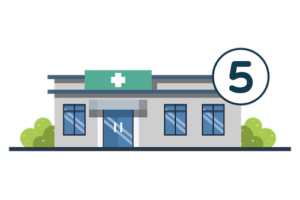3 Ways Online Scheduling Fuels Patient Acquisition and Practice Growth
By Chloe From Clearwave | September 27, 2023
Earning the distinguished classification of a “high-growth” practice is no small feat, especially when healthcare organizations are facing economic uncertainty, churn, rising labor costs and inflation across the board. How do they do it?
Top-performing practices recognize the importance of patient acquisition in their growth strategy and understand the winning formula to bringing in more patients: self-scheduling.
Meeting Patient Preferences for Scheduling Healthcare Appointments
Today, many patients want ownership and control over their ability to book appointments. In fact, research from Experian Health found that 76% of patients prefer to schedule appointments online or via a mobile device. Self-scheduling allows practices to meet patient demands and provide them with a superior experience, driving patient acquisition as well as overall revenue.
Ultimately, in today’s competitive healthcare market, online scheduling tools can be a significant competitive differentiator, often determining whether a patient chooses your practice or not.
Breaking Down the Revenue Benefits of Patient Self-Scheduling
How can one technology solution have such a big impact on a practice’s success? Let’s find out. Here are three ways patient self-service scheduling tools can help practices fuel acquisition and growth.
1. Offer 24/7 online self-scheduling
One of the biggest challenges with phone scheduling is that patients are forced to connect with a front-office worker during a practice’s confined hours of operation. Calling a practice during business hours may not always be possible if patients are working themselves, taking care of family or running errands. Additionally, even if patients can find the time to call a practice, they may drop off the call due to long hold times or simply not feel comfortable talking about their appointment needs over the phone, causing them to avoid calling. In both scenarios, practices lose out on bookings.
With online scheduling tools, practices can empower patients to book appointments around the clock, in seconds and at a time that is most convenient for them – all in the privacy of their own home. Not only does this approach help practices maximize bookings for non-urgent appointments, but it also enables practices to fill last-minute appointment slots.
The Orthopaedic Group (TOG) sees 500 patients each day and was challenged to increase bookings while facing ongoing staff churn. The company’s Director of Operations, Jennifer Lott, recently participated in a conversation on, “The Key to Booking More Patients Than Ever Before,” to share how Clearwave’s online self-scheduling tool has helped their practice streamline scheduling efficiency. She shares the key role after-hours scheduling has played in achieving this goal. For TOG today, 45% of the patients using online scheduling are booking their appointments after hours. Lott believes TOG likely wouldn’t have captured these patients if they had to place a call during business hours. You may find value in what she has to say here:
2. Reduce phone traffic and hold times, especially for busy office days
Most healthcare practices only have a few front-office workers staffing the phones to book patient appointments. If phone scheduling is the only option you offer patients, more often than not, the number of patients calling in, at any given time, will be greater than the number of available employees. This results in long hold times for patients, especially during busy periods, such as a Tuesday morning after a long holiday weekend, when everyone is calling to squeeze in a visit.
Long hold times lead to patient frustration, which can result in a subpar experience even before the first interaction with your practice – and that’s if the patient even hangs on hold long enough to speak with someone live. A portion of patients will hang up and give up on the practice altogether, leading to patient churn and decreased bookings.
Adding self-service scheduling into the mix, however, enables practices to avoid this situation entirely by giving patients a second option to book their appointments. With self-service scheduling, practices can:
- Reduce overall phone traffic by redirecting patients to online scheduling, which decreases hold times and creates a better experience for employees and patients.
- Take the burden of appointment scheduling from front-office workers, so they can focus on patient satisfaction, throughput and other important practice initiatives while better managing busy times.
- Meet the demands of patients who prefer online scheduling.
During the webinar conversation, Lott discussed how online scheduling has helped TOG bring in more patients (both new and existing) by reducing overall phone traffic, decreasing hold times – even on busy days – and enabling staff to better manage workloads. Hear her top tips:
3. Solve complex scheduling requirements to satisfy patients and providers
Every practice has complex scheduling workflows, which require significant staff training to ensure booked appointments follow provider and practice requirements. In cases where there are lots of providers on staff, each with their own unique booking guidelines, it can be extremely challenging for new staff to keep scheduling requirements straight – leading to errors, overbooking and frustrated physicians and patients. Additionally, when you’re short on staff, even experienced personnel can feel overwhelmed with scheduling responsibilities, resulting in simple mistakes and long hold times.
With 26 physicians across five locations, TOG was facing similar scheduling challenges. With so many different providers, each with nuanced scheduling needs, teaching new hires was difficult for TOG and training was slowing down the scheduling process. TOG recognized this complexity could cause prospective and existing patients to look elsewhere. The practice searched for a better approach to streamline scheduling while they dealt with ongoing staffing challenges and found the answer in smart, patient-self scheduling software.
TOG now offers a 24/7 scheduling platform that accurately books patients by matching the right patients to the right providers and appointment types. Hear Lott describe how Clearwave meets the practice’s complex scheduling requirements while enabling them to bring in more patients:
Put Online Scheduling to Work for Your Practice & Boost Acquisition
With Clearwave, TOG now sees 16% of appointments booked online being made by new patients, helping them increase acquisition every day. Learn more about TOG’s story here.
TOG’s story proves the power of online patient self-scheduling. You can achieve similar results, increasing bookings simply by enabling patients to schedule appointments at their convenience. Quickly convert new website visits into booked appointments, increasing patient acquisition and driving revenue. With smart patient self-scheduling software you can ensure accuracy, maximize patient throughput and balance staff workloads. See the winning patient acquisition formula that high-growth practices use, and get to the next level!
Clearwave’s online scheduling tool can help you grow your practice, without putting staff through more training or taking more time out of their day. Schedule a demo to see how or contact us today. A better experience for patients, providers and staff awaits!
Recommended for you
Related Posts
Long-Lines Giving You Blurry Vision?
Reading Time: 4 minutes Clearwave & Thomas Eye Group’s 10-Year Partnership Puts Patients First By Blakely Roth | June 18, 2024 In an era…
5 Ways Family Medicine & Primary Care Practices Can Increase Patient Acquisition
Reading Time: 6 minutes By Chloe From Clearwave | June 3, 2024 Family medicine and primary care practices serve as the front line of…
Clearwave Wins ‘Best Patient Registration & Scheduling Solution’ in 2024 MedTech Breakthrough Awards
Reading Time: 2 minutes ATLANTA – May 23, 2024 – Clearwave today announced it has been named the “Best Patient Registration and Scheduling Solution”…





